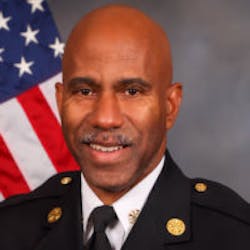OH Fire Chief Declines Vaccine in Solidarity with Police
Editor's note: Find Firehouse.com's complete coverage of the COVID-19 pandemic here.
On the day local firefighters are to receive the coronavirus vaccine, Toledo Fire and Rescue Department Chief Brian Byrd announced he will not be getting his, deciding instead to wait until police officers also are included in the protection.
"As a result of the decision to exclude our brothers- and sisters-in-law enforcement, I choose to stand in solidarity with them by respectfully declining my scheduled vaccination until they too, as fellow first responders, are given the opportunity to be included in the vaccination process," Chief Byrd said in an emailed statement.
As members of the Emergency Medical Services, the department's 518 uniformed firefighters are eligible to start receiving the Moderna vaccine at noon Monday at Mercy Health St. Vincent Medical Center, through a partnership with Toledo-Lucas County Health Department.
Health department staff, including Health Commissioner Eric Zgodzinski, will also be receiving the vaccine Tuesday at a clinic set up at the UAW at 2300 Ashland Ave.
But police officers were not included under the Ohio Department of Health's umbrella of first responders to receive the vaccine as part of Phase 1A. It has yet to be announced when officers will be vaccinated.
"In the early #vaccination phase, the focus is on those most at risk and essential healthcare workers caring for #COVID19 patients," Governor Mike DeWine said of the state's hierarchy in a tweet Monday.
The decision has been criticized by Toledo Police Chief George Kral, who tweeted last week, "These front line officers are on the street day and night serving and deserve better."
Fire Chief Byrd agreed, saying he also is disappointed in the decision and would be waiting to receive his vaccination until police officers are included. He declined to say which population should get bumped from the first phase to make the finite number of doses available to officers instead, but argued that officers have just as much risk for exposure — sometimes more — as EMS staff.
"Often police officers serve side by side with us or arrive before we do," Chief Byrd said.
Despite his own decision, the chief did encourage others in his department to get the vaccine to protect themselves, their families, and to prevent transmitting it to the community members they serve. Though, it's not known yet whether the vaccine can actually prevent persons from being carriers or transmitting the virus.
One of his crew members, Nicole Zmijewski, did get the shot Monday. She said she was apprehensive, considering the vaccine was developed so quickly, but after research she decided it was not only safe but important for her receive to set an example for those she helps train at the department. She wouldn't advocate for someone else to get it if she wasn't willing to get one herself, she said.
"I've been lucky so far, I haven't had coronavirus," Ms. Zmijewski said, noting that she's seen others die of the virus or require a ventilator. "I'd rather get immunity this way, with the vaccine than actually getting it and having the longterm effects of the virus itself."
It's unknown, however, what affect Chief Byrd's decision to way may have on other staff.
An earlier survey by the Lucas County Emergency Management Agency found about 68 percent of firefighters said they do want the vaccine, but it seems not even 68 percent have signed up for one yet.
The department couldn't provide a headcount for how many Toledo firefighters were scheduled to get it Monday or Wednesday, but the health department said only about 400 EMS workers had signed up for one across the county. At least one member of Maumee's fire department was seen in line awaiting the vaccine.
There's believed to be an estimated 1,100 people across the county who qualify as EMS workers.
Talks are underway to determine who should be bumped up to get the vaccine next if enough people from the first phase opt out, leaving leftover doses.
Dr. Kevin Casey, Chief Clinical Officer of Mercy Health — Toledo, doesn't think it will come to that.
"We realize there are some people electing not to get the vaccine at this point and we respect that decision, but there are enough people out there who would like to have the vaccine that we're not anticipating a point where we're going to have excess vaccine," Dr. Casey said.
Shannon Lands, a health department spokesman, said she believes the holiday may be driving the delay. Several EMS workers have asked for alternative days to get vaccinated because they could not be there this week, she said.
"We do plan on making it up," Ms. Lands said.
Mr. Rahe previously told The Blade that the fire department was struggling to maintain staffing levels as the virus ripped through the population. From March through August, there were about 35 to 40 infections, he said, but since November it has run rampant, infecting another 80 firefighters.
By contrast, police spokesman Lt. Kellie Lenhardt said Wednesday that a total of 84 officers have contracted the virus since March.
Also included in the first phase of the state's vaccine rollout has been health-care workers, psychiatric hospitals, and residents of nursing and assisted-living facilities, who all started receiving their shots within the last two weeks.
They are now scheduled to start getting their booster shots, to complete the set, next week, Matt Sapara, vice president of regional development and operations at Mercy, said. Anyone who receives the vaccine leaves with a date to return for their second shot, "so no one slips through the cracks," he said.
From here, Governor DeWine has said inoculations will go to Ohioans 65 and older, K-12 school employees, and younger people with severe developmental disabilities.
___
(c)2020 The Blade (Toledo, Ohio)
Visit The Blade (Toledo, Ohio) at www.toledoblade.com
Distributed by Tribune Content Agency, LLC.
